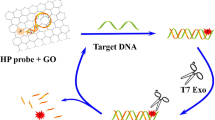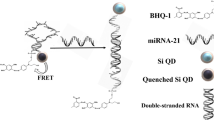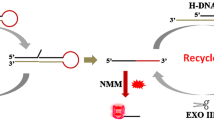Abstract
Single nucleotide polymorphism (SNP) biosensors are emerging rapidly for their promising applications in human disease prevention diagnosis, treatment, and prognosis. However, it remains a bottleneck in equipping simple and stable biosensors with the traits of high sensitivity, non-enzyme, and low cost. Double base mismatches mediated chain displacement reactions have attracted fascinating advantages of tailorable thermodynamics stability, non-enzyme, and excellent assembly compliance to involvement in SNP identification. As the base mismatch position and amount in DNA sequence can be artificially adjusted, it provides plenty of selectivity and specificity for exploring perfect biosensors. Herein, a biosensor with double base mismatches mediated catalytic hairpin assembly (CHA) is designed via one base mismatch in the toehold domain and the other base mismatch in the stem sequence of hairpin 1 (H1) by triggering CHA reaction to achieve selective amplification of the mutation target (MT) and fluorescence resonance energy transfer (FRET) effect that is composed of Cy3 and Cy5 terminally attached H1 and hairpin 2 (H2). Depending on the rationally designed base mismatch position and toehold length, the fabricated biosensors show superior SNP detection performance, exhibiting a good linearity with high sensitivity of 6.6 fM detection limit and a broad detection abundance of 1%. The proposed biosensor can be used to detect the KRAS mutation gene in real samples and obtain good recoveries between 106 and 116.99%. Remarkably, these extendible designs of base mismatches can be used for more types of SNP detection, providing flexible adjustment based on base mismatch position and toehold length variations, especially for their thermodynamic model for DNA-strand displacement reactions.
Graphical Abstract







Similar content being viewed by others
Data availability
The data will be available on request.
References
Claussnitzer M, Cho JH, Collins R, Cox NJ, Dermitzakis ET, Hurles ME, Kathiresan S, Kenny EE, Lindgren CM, MacArthur DG, North KN, Plon SE, Rehm HL, Risch N, Rotimi CN, Shendure J, Soranzo N, McCarthy MI (2020) A brief history of human disease genetics. Nature 577:179–189. https://doi.org/10.1038/s41586-019-1879-7
Roth TL, Marson A (2021) Annual review of pathology: mechanisms of disease. Annu Rev 16:145–166. https://doi.org/10.1146/annurev-pathmechdis012419-032626
Deng M, Ouyang C, Yang K, Lv W, Huang T, Li X, Zhou M, Wu H, Xie M, Shi P, Gao K, Yi R, Peng W, Chu H, Chen J (2022) An acid-labile bridged β-CD-based nano-hydrogel with superior anti-tumor drug delivery and release capacity. J Drug Delivery Sci Technol 78:103953. https://doi.org/10.1016/j.jddst.2022.103953
Zhang Y, Huang T, Lv W, Yang K, Ouyang C, Deng M, Yi R, Chu H, Chen J (2023) Controlled growth of titanium dioxide nanotubes for doxorubicin loading and studies of in vitro antitumor activity. Front. Bioeng. Biotechnol. 11. https://doi.org/10.3389/fbioe.2023.1201320
Lv W, Yang K, Yu J, Wu Y, Zhang M, Liu Z, Wang X, Zhou J, Ma H, Yi R, Chu H, Chen J (2023) A generalizable strategy for crosslinkable albumin-based hydrogels and application as potential anti-tumor nanoplatform. J Biomater Appl 37:1813–1822. https://doi.org/10.1177/08853282231166489
Yi R, Lv W, Zheng S, Zhang N, Zhang Y, Yang K, Huang T, Yang Y, Chu H, Chen J (2022) IFN-γ/Doxorubicin complex nanoparticles for enhancing therapy in the context of human ovarian carcinoma. Front Mater 9:944930. https://doi.org/10.3389/fmats.2022.944930
Chen L, Hong M, Luan C, Gao H, Ru G, Guo X, Zhang D, Zhang S, Li C, Wu J, Randolph PB, Sousa AA, Qu C, Zhu Y, Guan Y, Wang L, Liu M, Feng B, Song G, Liu DR, Li D (2023) Adenine transversion editors enable precise, efficient A•T-to-C•G base editing in mammalian cells and embryos. Nat Biotechnol. https://doi.org/10.1038/s41587-023-01821-9
Newby GA, Yen JS, Woodard KJ, Mayuranathan T, Lazzarotto CR, Li Y, Sheppard-Tillman H, Porter SN, Yao Y, Mayberry K, Everette KA, Jang Y, Podracky CJ, Thaman E, Lechauve C, Sharma A, Henderson JM, Richter MF, Zhao KT, Miller SM, Wang T, Koblan LW, McCaffrey AP, Tisdale JF, Kalfa TA, Pruett-Miller SM, Tsai SQ, Weiss MJ, Liu DR (2021) Base editing of haematopoietic stem cells rescues sickle cell disease in mice. Nature 595:295–302. https://doi.org/10.1038/s41586-021-03609-w
Villiger L, Rothgangl T, Witzigmann D, Oka R, Lin PJC, Qi W, Janjuha S, Berk C, Ringnalda F, Beattie MB, Stoffel M, Thöny B, Hall J, Rehrauer H, van Boxtel R, Tam YK, Schwank G (2021) In vivo cytidine base editing of hepatocytes without detectable off-target mutations in RNA and DNA. Nat Biomed Eng 5:179–189. https://doi.org/10.1038/s41551-020-00671-z
Yeh WH, Shubina-Oleinik O, Levy JM, Pan B, Newby GA, Wornow M, Burt R, Chen JC, Holt JR, Liu DR (2020) In vivo base editing restores sensory transduction and transiently improves auditory function in a mouse model of recessive deafness. Sci. Transl. Med. 12:1–12. https://doi.org/10.1126/scitranslmed.aay9101
Zhang X, Zhu B, Chen L, Xie L, Yu W, Wang Y, Li L, Yin S, Yang L, Hu H, Han H, Li Y, Wang L, Chen G, Ma X, Geng H, Huang W, Pang X, Yang Z, Wu Y, Siwko S, Kurita R, Nakamura Y, Yang L, Liu M, Li D (2020) Dual base editor catalyzes both cytosine and adenine base conversions in human cells. Nat Biotechnol 38:856–860. https://doi.org/10.1038/s41587-020-0527-y
Samad Hosseini S, Jebelli A, Vandghanooni S, Jahanban-Esfahlan A, Baradaran B, Amini M, Bidar N, de la Guardia M, Mokhtarzadeh A, Eskandani M (2022) Perspectives and trends in advanced DNA biosensors for the recognition of single nucleotide polymorphisms. Chem Eng J 441:135988. https://doi.org/10.1016/j.cej.2022.135988
Khodakov D, Li J, Zhang JX, Zhang DY (2021) Highly multiplexed rapid DNA detection with single-nucleotide specificity via convective PCR in a portable device. Nat Biomed Eng 5:702–712. https://doi.org/10.1038/s41551-021-00755-4
Petralia S, Vigilanza A, Sciuto E, Maffia M, Romanini A, Conoci S (2021) The MC1R single nucleotide polymorphisms identification by DNA-microarray on miniaturized silicon chip. Sens Actuators, B 346:130514. https://doi.org/10.1016/j.snb.2021.130514
Bathini S, Pakkiriswami S, Ouellette RJ, Ghosh A, Packirisamy M (2021) Magnetic particle based liquid biopsy chip for isolation of extracellular vesicles and characterization by gene amplification. Biosens Bioelectron 194:113585. https://doi.org/10.1016/j.bios.2021.113585
Purwidyantri A, Ipatov A, Domingues T, Borme J, Martins M, Alpuim P, Prado M (2022) Programmable graphene-based microfluidic sensor for DNA detection. Sens Actuators, B 367:132044. https://doi.org/10.1016/j.snb.2022.132044
Aggeli D, Karas VO, Sinnott-Armstrong NA, Varghese V, Shafer RW, Greenleaf WJ, Sherlock G (2018) Diff-seq: a high throughput sequencing-based mismatch detection assay for DNA variant enrichment and discovery. Nucleic Acids Res 46:e42–e42. https://doi.org/10.1093/nar/gky022
Wei X-r, Meng Y, Xu Q, Hu J, Zhang C-y (2022) Label-free and homogeneous detection of flap endonuclease 1 by ligation-promoted hyperbranched rolling circle amplification platform. Talanta 243:123342. https://doi.org/10.1016/j.talanta.2022.123342
Wu H, Ma X, Chu Y, Qi X, Zou B, Liu Y, Zhou G (2022) Digital nucleic acid signal amplification platform for highly sensitive DNA mutation analysis. Anal Chem 94:3858–3864. https://doi.org/10.1021/acs.analchem.1c04765
Ye X, Wang N, Li Y, Fang X, Kong J (2021) A high-specificity flap probe-based isothermal nucleic acid amplification method based on recombinant FEN1-Bst DNA polymerase. Biosens Bioelectron 192:113503. https://doi.org/10.1016/j.bios.2021.113503
Wu D, Yin B-C, Ye B-C (2011) A label-free electrochemical DNA sensor based on exonuclease III-aided target recycling strategy for sequence-specific detection of femtomolar DNA. Biosens Bioelectron 28:232–238. https://doi.org/10.1016/j.bios.2011.07.029
Zhang Y, Xu S, Chen J, Wang L, Bian L, Ye J, Weng L, Zhao X, Lin CT, Li S, Zhang D (2024) A biosensor using semi-DNA walker and CHA -FRET loop for ultrasensitive detection of single nucleotide polymorphism. Sens Actuators, B 400:134908. https://doi.org/10.1016/j.snb.2023.134908
Wang H-Q, Liu W-Y, Wu Z, Tang L-J, Xu X-M, Yu R-Q, Jiang J-H (2011) Homogeneous label-free genotyping of single nucleotide polymorphism using ligation-mediated strand displacement amplification with DNAzyme-based chemiluminescence detection. Anal Chem 83:1883–1889. https://doi.org/10.1021/ac200138v
Jauset-Rubio M, Ortiz M, O’Sullivan CK (2021) Solid-phase primer elongation using biotinylated dNTPs for the detection of a single nucleotide polymorphism from a fingerprick blood sample. Anal Chem 93:14578–14585. https://doi.org/10.1021/acs.analchem.1c03419
Jiang S, Liu Q, Hu J, Yuan D, Zhang Y, Zhang CY (2022) Target-triggered assembly of functional G-quadruplex DNAzyme nanowires for sensitive detection of miRNA in lung tissues. Sens Actuators, B 373:132689. https://doi.org/10.1016/j.snb.2022.132689
Zhang Y, Wang C, Zou X, Tian X, Hu J, Zhang C-y (2021) Simultaneous enzyme-free detection of multiple long noncoding RNAs in cancer cells at single-molecule/particle level. Nano Lett 21:4193–4201. https://doi.org/10.1021/acs.nanolett.0c05137
Modi S, Bhatia D, Simmel FC, Krishnan Y (2010) Structural DNA nanotechnology: from bases to bricks, from structure to function. J Phys Chem Lett 1:1994–2005. https://doi.org/10.1021/jz1004957|J
Burns JR, Stulz E, Howorka S (2013) Self-Assembled DNA Nanopores That Span Lipid Bilayers. Nano Lett 13:2351–2356. https://doi.org/10.1021/nl304147f
Wang Q, Wang J, Huang Y, Du Y, Zhang Y, Cui Y, Kong D-m (2022) Development of the DNA-based biosensors for high performance in detection of molecular biomarkers: more rapid, sensitive, and universal. Biosens Bioelectron 197:113739. https://doi.org/10.1016/j.bios.2021.113739
Li C, Wang Y, Li P-F, Fu Q (2023) Construction of rolling circle amplification products-based pure nucleic acid nanostructures for biomedical applications. Acta Biomater 160:1–13. https://doi.org/10.1016/j.actbio.2023.02.005
Yurke B, Turberfield AJ, Mills AP Jr, Simmel FC, Neumann JL (2000) A DNA-fuelled molecular machine made of DNA. Nature 406:605–608 https://www.nature.com/articles/35020524
Guo Y, Wei B, Xiao S, Yao D, Li H, Xu H, Song T, Li X, Liang H (2017) Recent advances in molecular machines based on toehold-mediated strand displacement reaction. Quant Biol 5:25–41. https://doi.org/10.1007/s40484-017-0097-2
Zhang DY, Winfree E (2009) Control of DNA strand displacement kinetics using toehold exchange. J Am Chem Soc 131:17303–17314. https://doi.org/10.1021/ja906987s
Liu J, Zhang Y, Xie H, Zhao L, Zheng L, Ye H (2019) Applications of catalytic hairpin assembly reaction in biosensing. Small 15:1902989. https://doi.org/10.1002/smll.201902989
Li M-X, Xu C-H, Zhang N, Qian G-S, Zhao W, Xu J-J, Chen H-Y (2018) Exploration of the kinetics of toehold-mediated strand displacement via plasmon rulers. ACS Nano 12:3341–3350. https://doi.org/10.1021/acsnano.7b08673
Irmisch P, Ouldridge TE, Seidel R (2020) Modeling DNA-strand displacement reactions in the presence of base-pair mismatches. J Am Chem Soc 142:11451–11463. https://doi.org/10.1021/jacs.0c03105
Lysne D, Hachigian T, Thachuk C, Lee J, Graugnard E (2023) Leveraging steric moieties for kinetic control of DNA Strand Displacement Reactions. J Am Chem Soc 145:16691–16703. https://doi.org/10.1021/jacs.3c04344
Ding S, Yu X, Zhao Y, Zhao C (2023) Identification of single nucleotide polymorphisms by a peptide nucleic acid-based sandwich hybridization assay coupled with toehold-mediated strand displacement reactions. Anal Chim Acta 1242:340810. https://doi.org/10.1016/j.aca.2023.340810
Xu M, Wang X, Tian J, Chen J, Wei X, Li W (2022) A clamp-improved universal amplified system for ratiometric fluorescent detection of single-nucleotide polymorphisms coupled with a novel dual-emissive silver nanocluster. Sens Actuators, B 367:132151. https://doi.org/10.1016/j.snb.2022.132151
Ambrogio C, Köhler J, Zhou Z-W, Wang H, Paranal R, Li J, Capelletti M, Caffarra C, Li S, Lv Q, Gondi S, Hunter JC, Lu J, Chiarle R, Santamaría D, Westover KD, Jänne PA (2018) KRAS dimerization impacts MEK inhibitor sensitivity and oncogenic activity of mutant KRAS. Cell 172:857-868.e15. https://doi.org/10.1016/j.cell.2017.12.020
Kostyrko K, Román M, Lee AG, Simpson DR, Dinh PT, Leung SG, Marini KD, Kelly MR, Broyde J, Califano A, Jackson PK, Sweet-Cordero EA (2023) UHRF1 is a mediator of KRAS driven oncogenesis in lung adenocarcinoma. Nat. Commun. 14. https://doi.org/10.1038/s41467-023-39591-2
Funding
This work was supported by the Scientific Research Fund of Hunan Provincial Education Department (22A0348), the Natural Science Foundation of Hunan Province, China (Grant No. 2020JJ5156), and the National College Students’ Innovation and Entrepreneurship Training Program, China (No. S202310534001 and S202310534137).
Author information
Authors and Affiliations
Corresponding authors
Ethics declarations
Conflict of interest
The authors declare no competing interests.
Additional information
Publisher's Note
Springer Nature remains neutral with regard to jurisdictional claims in published maps and institutional affiliations.
Supplementary Information
Below is the link to the electronic supplementary material.
Rights and permissions
Springer Nature or its licensor (e.g. a society or other partner) holds exclusive rights to this article under a publishing agreement with the author(s) or other rightsholder(s); author self-archiving of the accepted manuscript version of this article is solely governed by the terms of such publishing agreement and applicable law.
About this article
Cite this article
Wang, L., Bu, S., Xu, S. et al. Double base mismatches mediated catalytic hairpin assembly for enzyme-free single-base mutation detection: integrating signal recognition and amplification in one. Microchim Acta 191, 334 (2024). https://doi.org/10.1007/s00604-024-06366-5
Received:
Accepted:
Published:
DOI: https://doi.org/10.1007/s00604-024-06366-5




